|
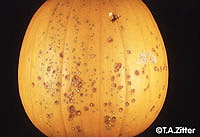
Scab lesions on pumpkin rind with active sporulation in the sunken lesions. Courtesy
T. A. Zitter. (Click image for larger view)
| |
Contributed by
T. A. Zitter
Dept. of Plant Pathology
Cornell University
Ithaca, NY 14853-4203
Although scab, or gummosis, is rarely a problem now for slicing and pickling cucumbers, because of the availability of many resistant cultivars, it remains a significant problem for
summer and winter squash, pumpkin, melon, and watermelon. The disease was first described
in the United States in New York in 1887. It has been reported in many cool, temperate parts
of North America, Europe, and Asia.
Symptoms
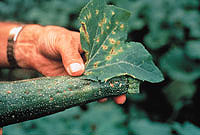
Fig. 1.Scab caused by Cladosporium cucumerinum. Lesions on zucchini squash leaf and fruit. Courtesy T. A. Zitter. (Click image for larger view.) |
|
The fungus can attack any aboveground portion of the plant, including leaves, petioles, stems, and fruits. On leaves and runners, pale green, water-soaked areas are the initial symptoms. These spots gradually turn gray to white and may become "shot-holed" in appearance. A chlorotic halo appears around the lesion (Fig. 1). If weather conditions are favorable for disease development, scab can deform young leaves, especially of summer squash. The apical runners of young plants such as melons can be killed.
|
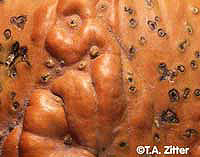
Fig. 2. Extensive early infection of pumpkin by scab caused malformation of the rind surface and rather deep lesions. Courtesy T. A. Zitter. (Click image for larger view). |
|
Scab can produce the greatest damage on fruit. The appearance of fruit lesions varies in different crops, depending on the susceptibility of the crop. Spots first appear as small, sunken areas similar to insect stings, about 3–4 mm in diameter (Fig. 1). A sticky substance may ooze from the infected area, especially on fleshy fruit. Secondary soft-rotting bacteria may also invade the cavities and lead to foul-smelling decay. On pumpkin fruit, lesions may appear as sunken craters and can lead to misshapen areas on the fruit (Fig. 2); these lesions can be confused with those caused by anthracnose. On more resistant watermelon fruits, lesions appear as raised blisters or superficial pimples.
Causal Organism
|
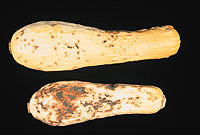
Fig. 3. Profuse sporulation on squash fruit. Courtesy T. A. Zitter. (Click image for larger view.)
|
Scab is caused by Cladosporium cucumerinum Ellis & Arth. Extensive presence of the fungus is not evident on infected leaves and stems, but sporulation can be profuse on fleshy fruit (Fig. 3). The fungus consists of septate and branching mycelium which appears hyaline when young and turns greenish to black with age. Conidia are oblong, colored, mostly continuous (or, in some cases, one-septate), and borne terminally on short, branched, dark conidiophores (Fig. 4). The one-septate conidia measure 4.6–5.7 × 16.4-22.5 µm. Structures intermediate between conidiophores and conidia also become detached and germinate. These are larger than conidia, have thicker walls, and have one to many cells.
|
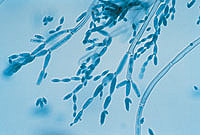
Fig. 4. Conidia of C. cucumerinum.
Courtesy L. W. Hsu. (Click image for
larger view).
|
Disease Cycle
The scab organism survives in soil on squash, melon, and pumpkin vines and reportedly may grow extensively as a saprophyte. The fungus may also be seedborne. It is disseminated on clothing and equipment and by insects. The conidia can survive long-distance spread in moist air. The most favorable weather conditions for disease development are wet weather (valley fogs, heavy dews, and light rains) and temperatures near or below 21°C, which usually occur after mid-season in the northern United States. At 17°C the growing tips of young plants are killed. Conidia germinate and enter susceptible tissue within 9 hr. A spot may appear on leaves within 3 days, and a new crop of spores is produced by the fourth day.
Control
The use of scab-resistant cultivars is an effective means of control in cucumber. Although scab resistance or tolerance has been reported in Cucurbita pepo, C. maxima, and C. moschata, no resistant cultivars are commercially available.
Because the scab fungus appears to overseason well, rotation of cucurbit crops with nonhost crops is necessary, with two or more years between cucurbit crops. The use of disease-free seed is important. Select sites that have well-drained soils and are conducive to good air drainage to allow for rapid drying of the foliage.
Protectant fungicides are recommended for control. However, fungicide sprays are less effective during extended periods of cool, wet weather, because of the short disease cycle.
Selected References
Crossan, D. F., and Sasser, J. M. 1969. Effect of rotation with corn on cucurbit scab. Plant Dis. Rep. 53:452-453.
Morton, D. J., Crossan, D. F., and Manning, W. J. 1967. Reduction of cucurbit scab by a one-year rotation with corn. Plant Dis. Rep. 51:495-497.
Strider, D. L., and Konsler, T. R. 1965. An evaluation of the Cucurbita for scab resistance. Plant Dis. Rep. 49:388-391.
Walker, J. C. 1950. Environment and host resistance in relation to cucumber scab. Phytopathology 40:1094-1102.
RETURN TO APSnet FEATURE STORY
